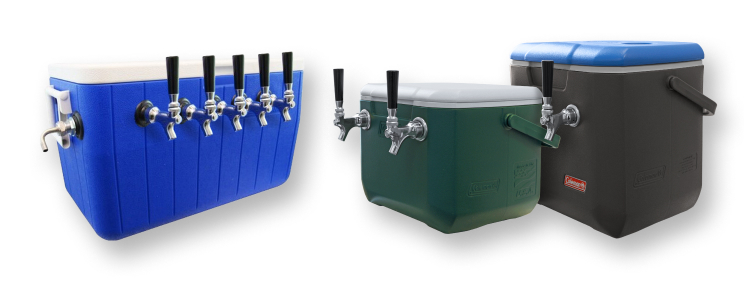How to Keep Beer Cold During Picnic, Camping, or Beach Party?
Posted by Ron on 14th Jun 2021
Among all of the problems science has yet to solve, “how to keep beer cold” is definitely one that requires more attention. There have been a few temporary solutions and life hacks, but is there a permanent solution that will end this problem once and for all? We think we might have one - read on and to find out.
How to Keep Your Beer Cold During Hot Weather?
If you enjoy having perfectly chilled draught beer at your outdoor event or want to know how to keep beer cold at a party, but don’t know how to keep beer cold without a fridge, a perfect solution for you would be a jockey box.
Even though you may not have known them by name at the time, chances are you’ve seen jockey boxes at a catered event like a wedding, outdoor festival, or party. In fact, they’ve been getting more popular among Beverage Craft customers and overall, mainly due to the ease of use and presentation.
In simple terms, a jockey box is a portable draught beer system used to pour beer or any kegged beverage anywhere you want since it does not require electric power and relies purely on ice for refrigeration. The “jockey” in the name comes from the phrase “jockey around”, which means you can easily move this box around.

From a technical point of view, a jockey box is made from an insulated cooler - think of it as a portable container to keep beer cold. Jockey boxes typically consist of the following parts:
- Body/reservoir with a drain
- Stainless steel coil (or plate)
- Shank
- Cooler coupling
- Faucet + faucet handle
- Beer line
- Air line
- Keg coupler
- CO2 tank with a double-gauge regulator
- Ice (not a part of a jockey box per se but still required to maintain the best temperature to keep beer cold)
The way a jockey box works is pretty simple: once it’s been set up (more on that below), you connect your jockey box to a keg, and then it’s just like your good old friend, the kegerator.
You open the faucet, and the beer starts flowing, as it leaves the keg, it flows through the beer line into the jockey box where it travels through a stainless-steel coil (or plate) until it reaches the faucet on the front, which is where the beer is dispensed. Magic? Not exactly - it’s all in the ice.
When you fill a jockey box with ice, it surrounds the coil, which chills the beer down to a proper serving temperature as it travels through the coil. As a result, you get a nice, cold pint straight out of the box, so to say.
Whether you want to keep beer cold in car or keep beer cold camping, jockey boxes are a perfect option - they’re affordable, they’re small, they’re portable, and most of all, they’re easy to use!
<
How to Set Up a Beer Jockey Box
First of all, you need to have all the components ready, including the jockey box itself, beer and air lines, CO2 tank, keg coupler, keg, and a couple of bags of ice. Now, let’s see how to connect all those elements and how to keep beer cold in a cooler.
- Make sure the faucet is shut so no beer gets spilled
- Take the keg coupler and attach it to the beer keg, then pull and twist
- Turn on the CO2 the tank and adjust the pressure on the regulator (typically, it should be between 25 and 35 psi for coil-based jockey boxes and 35-45 psi with cold plate jockey boxes)
- Pour enough ice into the jockey box to cover the coils and then fill it with some water (for coil-based jockey boxes) or simply fill it about ⅔ full of ice for cold plate jockey boxes - that’s how to keep beer lines cold
- Open the faucet and enjoy a cold pint!
To keep your beer cold at all times and prevent it from being too foamy, you should also chill the keg using an ice bucket or a keg sleeve. This will help you maintain the proper temperature of the beer from keg to glass.
Also, remember to clean your jockey box after every use - we’ve got an article on the Beverage Craft blog covering jockey box cleaning in detail, be sure to read it as well.

